When you walk through any personal care section, you’ll see a wide array of razors neatly divided into men’s and women’s razors sections. But beyond packaging and marketing, have you ever really thought about the differences between men’s and women’s razors? It’s a question on many people’s minds, and the answer isn’t always as simple as the pink and blue packaging might suggest. While both types of razors have the basic function of removing hair, a closer look reveals subtle yet significant differences in design, function, and even marketing approaches. Understanding these differences can help you make a more informed choice for a more comfortable, effective, and cost-efficient shaving experience tailored to your personal needs. In this comprehensive guide, we’ll delve into the complex distinctions between these seemingly similar grooming tools, exploring everything from handle ergonomics and blade technology to the often-discussed “pink tax” and real user experiences.
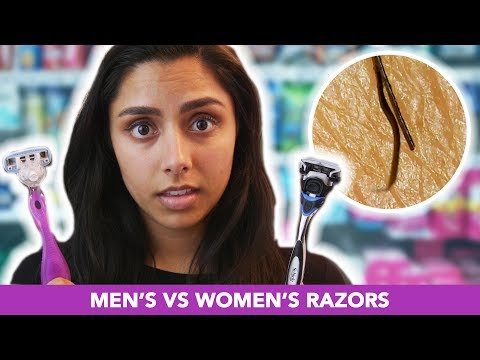
Deconstructing Design: Men’s and Women’s Disposable Razors
To truly understand the differences between men’s and women’s razors, we need to look beyond surface appearances and analyze their physical design elements. While the core function remains unchanged, manufacturers often incorporate specific features into razors targeted at different genders, ostensibly to meet their unique shaving needs and preferences. Let’s break down some of the key design differences commonly found in disposable razors:
Handle Ergonomics and Grip For Men’s and Women’s Disposable Razors:
One of the most immediate differences often lies in the handle design. Men’s disposable razors typically feature longer, sometimes thicker handles. This design aims to provide a more secure grip, offering better control and leverage when shaving larger areas like the face and chest. The extended handle can also be advantageous for reaching certain body parts.
In contrast, women’s disposable razors usually have shorter, more contoured handles. These handles are often lighter and frequently feature rubber or textured grips to enhance operability and secure holding in wet conditions. This design is commonly attributed to the need for greater flexibility when women shave more complex and curved body parts like legs, underarms, and bikini lines. The difference in ergonomic design is a fundamental aspect differentiating men’s and women’s razors, as ergonomics are crucial for control and comfort during shaving. Numerous studies highlight the importance of handle design for grip and control, indicating this is a universal need regardless of marketing gender. Even patents exist for razor handle designs that improve grip structures. Medical razors also emphasize ergonomic design for ease of use. Some brands specifically mention that ergonomic handles offer better shaving control. Women’s razors are characterized by more curved handles for better grip. Even neck razors prioritize ergonomic design. Safety razors also focus on handle ergonomics. Gillette emphasizes the science behind its ergonomic grips. Styling razors also highlight ergonomic handles for control.

Cartridge and Blade Configuration For Men’s and Women’s Disposable Razors:
The design of the cartridge and the configuration of the blades also contribute to the differences between men’s and women’s disposable razors. Men’s disposable razors typically offer fewer blade options, usually between one to three blades. The focus here is on effectively shaving thicker, coarser facial hair. While multi-blade options exist for men, many disposable razors for men still emphasize simple and effective shaving. Some dermatologists recommend single or double blades to reduce irritation in men prone to razor bumps.
On the other hand, women’s disposable razors commonly feature multi-blade cartridges with three, four, or even five blades. The rationale is to achieve a smoother, closer shave over larger body surface areas and effectively handle finer hair. The spacing between blades may also be optimized for this purpose. Both men’s and women’s razors often have pivoting cartridges to allow blades to better conform to skin contours, though there may be differences in flexibility and range of motion. Women’s razors typically have rounded, oval edges to prevent cutting sensitive areas. The difference in blade count reflects the typical hair type and density for each gender. Men’s razors prioritize shaving thicker beards, while women’s razors aim to remove finer hair over larger areas for a smooth result. Men’s razors are designed for coarse hair with a larger blade angle. Women’s razors usually have wider cartridges to cover larger areas. However, more blades don’t always mean a better shave and may increase irritation due to drag. Several studies explain how multi-blade razors pull hair and cut it below the skin, potentially causing irritation and ingrown hairs. Some experts recommend fewer blades to reduce irritation. Blade angles may differ, with men’s razors typically having a larger angle than women’s to accommodate coarser hair.
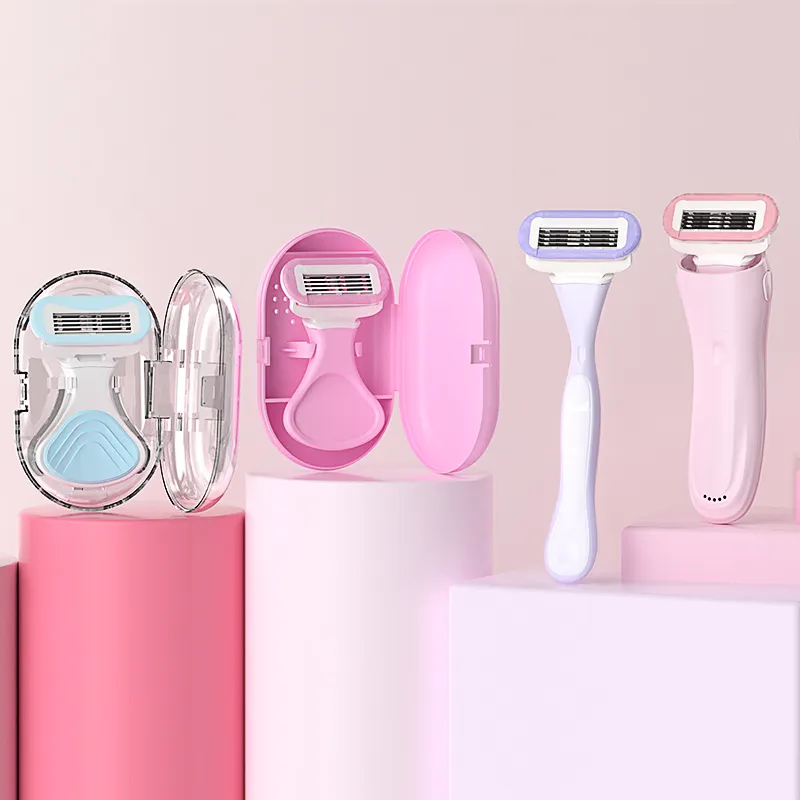
The Importance of Lubrication Strips For Men’s and Women’s Disposable Razors:
Lubrication strips are a common feature in modern disposable razors, playing a crucial role in enhancing shaving comfort and reducing friction. However, there can be significant differences in the size, composition, and prominence of these strips between men’s and women’s razors, further highlighting the distinctions.
Women’s disposable razors are often marketed with larger, more prominent lubrication strips. These strips are usually infused with higher concentrations of moisturizing agents like aloe vera, vitamin E, or other skin-soothing ingredients. This emphasis caters to the perception that women’s skin may be more prone to dryness and irritation during body shaving, with larger strips aiming to counteract this. Women’s razors typically have wider cartridges and more lubrication strips for smoother movement over larger skin areas. Some even encase blades in solid moisturizing creams.
While men’s disposable razors also have lubrication strips, they may be smaller or less advertised. Marketing for men’s products often focuses more on blade sharpness and efficiency for handling coarser facial hair. The emphasis on larger lubrication strips in women’s razors highlights a marketing focus on addressing skin sensitivity issues during body shaving. Marketing suggests women’s skin needs more lubrication, possibly due to larger shaving areas or perceived sensitivity. Women’s razors usually have more skincare strips. Lubrication strips contain various ingredients, some potentially controversial. Research indicates the presence of chemicals like polyethylene glycol (PEG) in lubrication strips, raising potential health concerns. Some strips contain aloe vera, vitamin E, or plant oils.
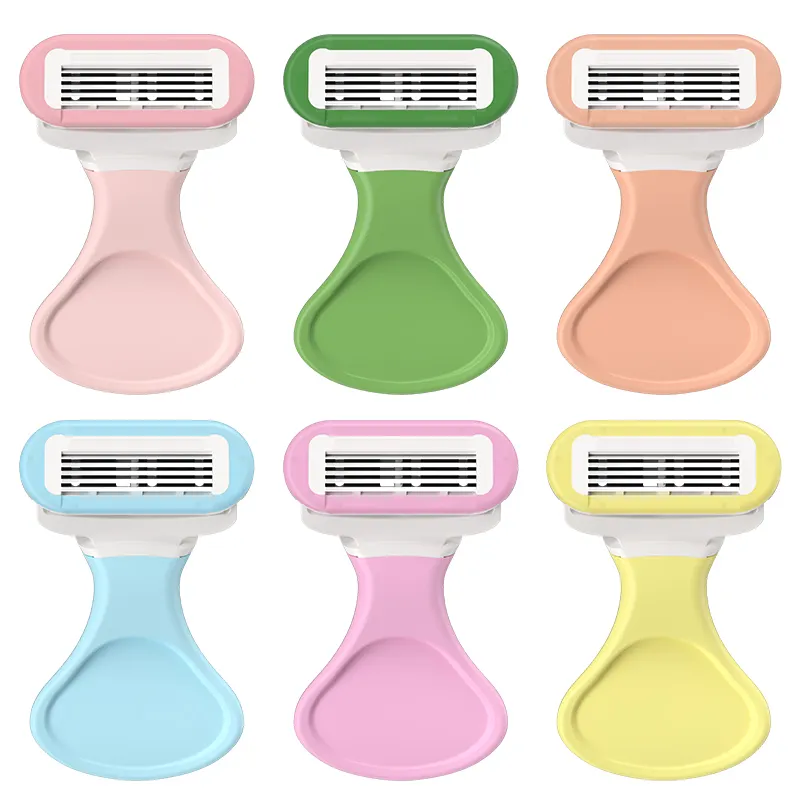
Color and Aesthetics For Men’s and Women’s Disposable Razors:
Finally, the visual design and color palette of men’s and women’s disposable razors contribute to their unique marketing and perceived differences. Men’s razors typically follow a more traditional masculine aesthetic with darker colors like blue, black, and gray, focusing on a stylish and functional appearance.
In contrast, women’s razors often feature lighter, brighter colors such as pink, purple, and soft tones. Designs may also include more curves and softer visual elements. These aesthetic choices are largely driven by marketing strategies aimed at attracting specific gender groups. Research shows color selections align with traditional gender marketing norms, with women often associated with lighter colors and men with darker ones. This reinforces the stereotype of female passivity through the use of light color schemes.
Men’s and Women’s Disposable Razors Performance Insights: Do They Shave Differently?
Beyond design elements, a key question remains: Do the differences between men’s and women’s disposable razors translate to actual performance variations during shaving? Let’s examine this aspect:
Handling Hair Thickness and Density For Men’s and Women’s Disposable Razors:
As previously mentioned, men’s razors are typically designed to handle thicker, denser hair. Blades may be sharper or angled differently to effectively shave coarser hair. For men with particularly thick beards, a strong, efficient shaving motion is crucial for a comfortable, close shave.
Women’s razors, while also needing to be sharp, are usually optimized for shaving larger areas of finer hair. The multi-blade design aims to effectively capture and remove these finer hairs, resulting in a smooth surface on legs, arms, and other body parts.
Comfort and Irritation Potential For Men’s and Women’s Disposable Razors:
Comfort and the likelihood of skin irritation are key considerations for both men and women when choosing a razor. Women often shave larger, more sensitive areas, so they may prioritize razors with sufficient lubrication to minimize friction and reduce the risk of razor burn. The ergonomic handles on many women’s razors also enhance comfort by providing better control.
Men, especially those with sensitive facial skin, may also seek razors with lubricating features. However, some men might find that simpler razors with fewer blades cause less irritation due to fewer blades passing over the skin.
Suitability for Specific Shaving Areas For Men’s and Women’s Disposable Razors:
Design differences often make certain razors better suited for specific shaving areas. The longer handles and potentially more aggressive blades of some men’s razors may be well-suited for the contours of the face and neck. The smaller, square-shaped cartridges of men’s razors are also better for precise facial shaving.
Many women’s razors have shorter, more maneuverable handles and flexible cartridges, making them suitable for handling the curves and angles of legs, underarms, and bikini lines. The emphasis on lubrication in women’s razors also caters to the potentially more sensitive skin in these areas. The oval-shaped cartridges of women’s razors are better suited for body curves.
The Cost Dilemma: Examining Price Differences For Men’s and Women’s Disposable Razors:
An important aspect of the differences between men’s and women’s disposable razors is often the price. It’s commonly observed that products marketed to women, including razors, are often priced higher than similar products for men—a phenomenon known as the “pink tax.” Studies indicate that women’s razors are typically more expensive than men’s. Women’s four-blade razors are 66% more expensive, and five-blade razors are also priced higher.
Initial Purchase Price Comparison
When comparing disposable razors with similar features (e.g., the same number of blades and comparable lubrication), women’s razors are usually slightly more expensive than their male counterparts. This price difference may stem from various factors, including marketing costs, perceived value, and minor differences in materials or features. Scented women’s razors may also have slightly higher production costs.
Long-term Value and Replacement Costs
While the initial purchase price is a factor, considering long-term value and the costs of replacing cartridges or buying new disposable razors is also important. The pricing trends observed in initial purchases often continue into replacement products, meaning women may end up paying more for their shaving needs. Replacement cartridges are more expensive than replacement safety razor blades.
Is the Price Difference Justified For Men’s and Women’s Disposable Razors?
Whether the price difference between men’s and women’s disposable razors is justified is a topic of ongoing debate. While there may be minor design differences that slightly affect manufacturing costs, many believe the price gap is largely driven by marketing and social perceptions rather than significant differences in production costs or actual razor performance. Consumers are increasingly questioning whether they’re paying extra simply because a product is marketed to their gender. Studies show a lack of significant functional differences, indicating marketing plays a substantial role in pricing. Companies profit from gender stereotypes by increasing prices on “fancy color-coded” women’s products.
Key Table: Average Price Comparison (Chapter: The Cost Dilemma)
| Number of Blades | Average Price (Men) | Average Price (Women) | Price Difference | Source |
| Four | $1.94 | $3.02 | 66% higher | PMC8484976 |
| Five | $4.03 | $5.14 | 47% higher | PMC8484976 |
Rationale for the Table: This table directly addresses user questions about price differences, using study data to visually highlight the “pink tax” phenomenon and provide specific evidence of cost variations based on blade count.
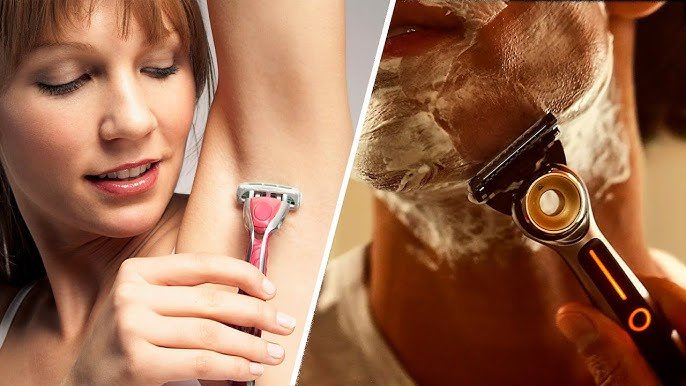
Beyond Marketing: What Users Say For Men’s and Women’s Disposable Razors?
Ultimately, the most insightful perspectives on the differences between men’s and women’s disposable razors come from users themselves. Online reviews and user evaluations often reveal valuable insights into the real-world performance and perceived value of these products.
User Preferences and Experience
Many users report finding little significant difference in actual shaving performance between men’s and women’s disposable razors with similar features. Some women prefer the simple design and typically lower cost of men’s razors. Some men may choose women’s disposable razors with more lubrication for added comfort. User experiences suggest functional differences may not be as pronounced as marketing implies, leading some to cross gender lines based on personal preference.
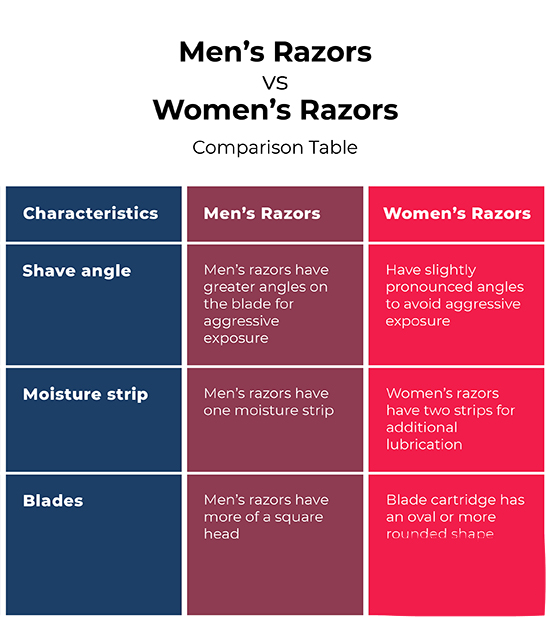
Challenging Gender Norms For Men’s and Women’s Disposable Razors
Increasingly, consumers are challenging traditional gender marketing of razors and selecting products based on personal needs rather than marketing targets. This trend indicates growing awareness that the “best” razor is a personal choice not dictated by gender stereotypes. Consumers are becoming less influenced by gender marketing and more focused on product characteristics and personal needs, signaling a shift toward more informed purchasing decisions.
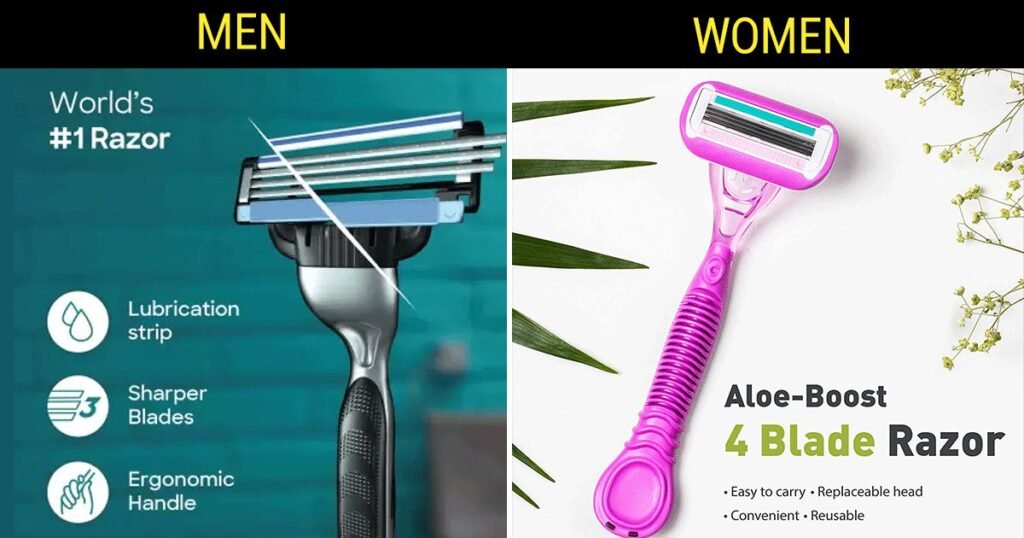
Travel Considerations For Men’s and Women’s Disposable Razors
For traveling with disposable Men’s and Women’s Disposable Razors, the good news is that transportation safety authorities like the TSA and similar aviation authorities typically apply the same guidelines to both men’s and women’s razors. Disposable razors are usually allowed in carry-on and checked baggage, making them a convenient choice for maintaining grooming on the go. Safety razors have different regulations when carrying blades.
Environmental Impact For Men’s and Women’s Disposable Razors
Regardless of whether disposable razors are marketed to men or women, their environmental impact is a concern. Most are made of plastic and metal that aren’t easily recyclable, ending up in landfills. Billions enter landfills yearly. Eco-conscious consumers can consider reusable razors with replaceable cartridges or brands with recycling programs. Some companies offer recycling programs and biodegradable options.
Conclusion: Choosing What Suits You For Men’s and Women’s Disposable Razors
In summary, while design and marketing differences do exist between men’s and women’s disposable razors, the actual functional differences may be smaller than marketing suggests. Factors like handle ergonomics, blade configuration, and lubrication levels may vary, but ultimately, the best razor for you is one that effectively removes hair, feels comfortable, and meets your personal needs and preferences. Don’t let pink or blue packaging alone sway your choice—consider what features matter most to you and select a razor that offers the best shaving experience, regardless of its targeted gender market. Understanding the differences between men’s and women’s razors is an important step toward making a more informed and potentially more satisfying grooming choice.



